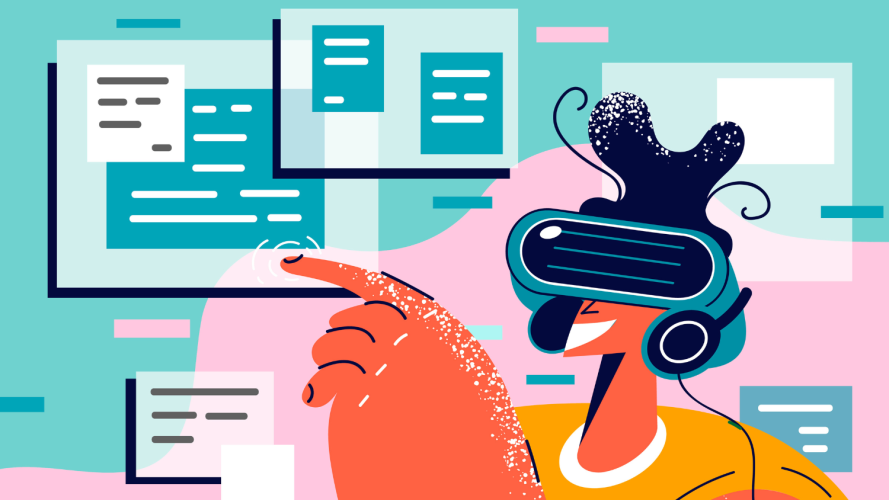At Salesforce, we’re not just building AI, we’re studying how it’s reshaping our own work. This research takes an inward look at how AI is transforming the day-to-day realities of our user experience (UX) design team: how workflows are evolving, what new skills are emerging, and how expectations are shifting.
By understanding our own changes to our Jobs to be Done (JTBD), we’re better equipped to anticipate how AI may impact the broader workforce, and to design solutions that support the future of work. Let’s take a look at what’s changing and what the opportunities are for designer growth.
Here’s what you’ll learn:
What are Jobs to be Done for UX Designers?
Five ways design work is shifting and how to respond
Encourage designers to experiment
What are Jobs to be Done for UX designers?
Design work spans a set of core JTBD, which is a framework that focuses on understanding what people are trying to accomplish when they buy or use a product or service. What’s the job or task they’re trying to complete?
Here’s how Salesforce designers are framing their JTBD:
- Understand the business, technology, and domain: Designers need to grasp business goals, domain context, and technical constraints.
- Understand the user: Designers must stay connected to user needs, pain points, and behaviors that shape design decisions.
- Create and evolve product design visions: Designers explore ideas and generate concepts and artifacts that express a compelling product vision.
- Deliver production-ready designs: Designers translate ideas/visions/prototypes into high-quality, vetted, implementation-ready assets.
- Collaborate across functions: Designers must work with cross-functional partners to drive alignment and shared outcomes.
- Contribute to design culture and craft: Designers are expected to strengthen the design team’s practices, people, and standards.
- Grow professionally: Designers want to keep their skills sharp, build new skills, and stay current on the industry and practice.

Five ways design work is shifting and how to respond
As AI shows up across JTBD for designers, it’s reshaping what UX work looks like and what skills designers need to thrive. What follows are five key shifts we’re observing in the role, along with actionable ways to support teams through upskilling and tooling.
1. Efficiency is now a core expectation
Designers are under growing pressure to “do more with less,” to get to quality faster, and to actively explore how AI tools can boost productivity. Think of it like going from hiking to mountain biking.
What this looks like
AI is accelerating many aspects of the workflow: summarizing research, generating design concepts, building full-fledged prototypes, creating documentation, and tightening feedback loops. It’s also making day-to-day communication more efficient by auto-summarizing Slack threads and generating Gemini meeting notes.
But without the right skills, these tools don’t always offer efficiency gains. Designers need to know how to write effective prompts, choose the right tools for the job, and evaluate the AI use cases that can truly save time.
How to respond
Help designers build prompt fluency and sharpen their instincts about when to bring AI in. We also have an opportunity to refocus the conversation on the value of using AI in pursuit of richer, better outcomes, not just faster ones.
2. Designers are stretching from makers to directors and curators
The role is moving from execution to strategic oversight. Designers now spend more time guiding, refining, and aligning design work to goals. Think of it like going from being hands-on to wearing a headset and calling the plays.
What this looks like
As AI creates components, prototypes, and documentation, designers are stepping back to review that work against intent, standards, and best practices. Direction-setting, critique, and editorial judgment are becoming even more central to the role of a designer.
How to respond
Reinforce design direction and critique skills through frameworks and coaching that are tailored for working with AI. Use AI tools and purpose-build agents to serve as co-reviewers to prompt questions about intent, flag inconsistencies, and identify areas that may need refinement or polish.
3. There’s a deepening focus on experience and interaction quality
What “good” looks like is beginning to shift as designers gain space to explore, “vibe check,” and get deeper. Think of it like graduating from twirls to triple flips.
What this looks like
Designers are spending more time “exploring their whims.” They’re experimenting, thinking more deeply about interactions, getting to a fidelity where they can actually feel and assess their ideas, and testing their work across real-world use cases to see where experiences break down. Designers are increasingly shifting emphasis from polished UI/visuals to deeper UX thinking, backed by evidence and experimentation.
How to respond
Support designers in deepening their interaction design and motion skills. AI tools and purpose-built agents could help expose less-experienced designers to examples of “great” interaction design, and provide coaching or critique modeled after expert workflows. They could also help stress-test flows, accessibility or inclusivity standards, real-world use cases, or overlooked edge cases.
4. Systems thinking is becoming a core design skill
As AI actually helps build the “thing,” there’s an increasing desire and capacity to spend energy ensuring the right things are being built. Think of the difference between a soloist and an orchestra.
What this looks like
Designers are spending more time connecting the dots across products, teams, and work streams. They’re engaging in alignment meetings and cross-functional conversations to understand the bigger picture and how their piece fits into it. But, much of that context-gathering still happens manually, and can be time-consuming.
How to respond
Strengthen designers’ ability to navigate complex ecosystems by giving them better access to context. AI tools and purpose-built agents could curate knowledge from decks, meeting notes, and Slack threads to help designers understand adjacent product domains, related initiatives, and cross-product dependencies — without sitting in every meeting.
5. Generalist skill sets are gaining value
With AI lowering barriers between roles, designers are increasingly flexing across functions and disciplines. Think of it as less relay and more rugby, where everyone moves the ball down the field together. It’s messy, collaborative, and the team adapts dynamically to the situation.
What this looks like
Designers are now conducting their own research, writing product requirements documents, and even generating or evaluating code. Also, they’re reviewing AI-generated assets created by product managers or others, and need to assess their quality. While they don’t need deep expertise in these adjacent domains, they do need enough fluency to direct AI effectively and curate what comes out.
How to respond
Help designers build lightweight fluency in adjacent roles like product management, engineering, and research. AI tools and purpose-built agents could offer onboarding into new domains and provide in-the-moment coaching to help designers assess outputs beyond their traditional scope.
Encourage designers to experiment
In a fast-changing landscape, experimentation is one of the best ways designers can learn and lead. Try new tools, test different use cases, and play with prompts.
Teams that make room for tinkering and knowledge sharing are building the fluency and confidence needed to navigate change, and shape how AI gets used.







